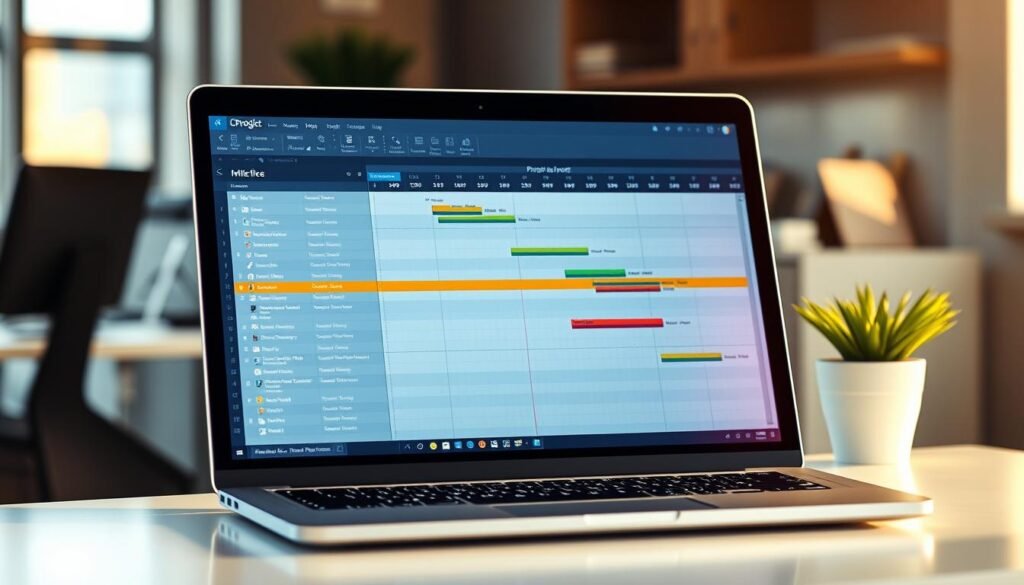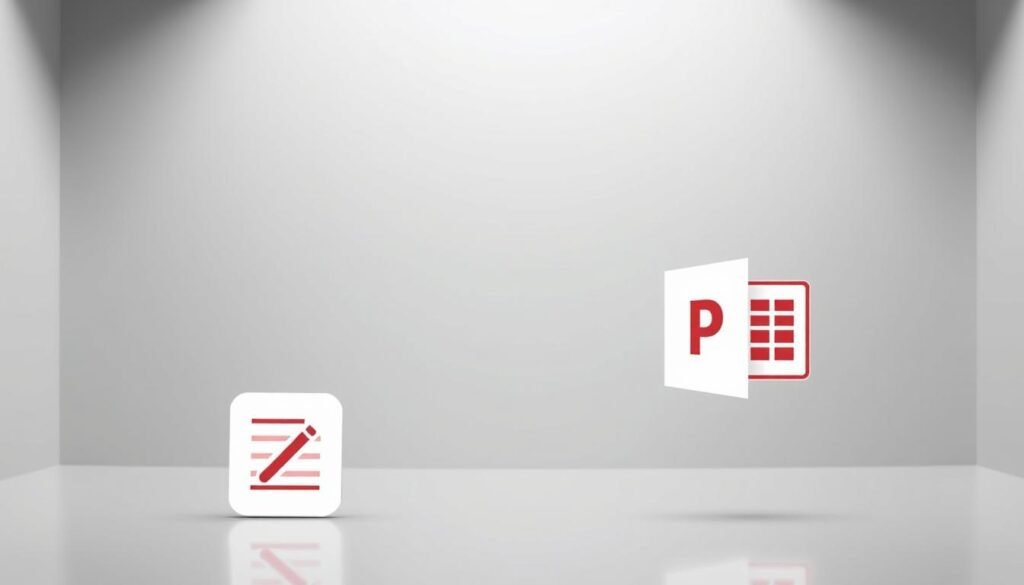Did you know that 70% of businesses struggle to find the right collaboration tool for their teams? With so many options, picking the right one can be tough. In project management, Project and Planner are two top choices.
Project is for big, complex projects and experienced managers. Planner is better for small teams and projects. But, which one is best for your business?
Choosing the right collaboration tool is key for team success. In this article, we’ll look at the features, pricing, and use cases of both tools. This will help you decide wisely.
Key Takeaways
- Understand the key differences between Project and Planner
- Learn which tool is best suited for your business needs
- Discover the importance of choosing the right collaboration tool
- Compare the features and pricing of both tools
- Make an informed decision for your team’s success
Introduction to Microsoft Planner and Project
It’s important to know the differences between Microsoft Planner and Microsoft Project. Both tools aim to boost productivity. But they serve different needs and have unique features.
Overview of Microsoft Planner
Microsoft Planner helps teams manage their work. It lets users make plans, assign tasks, and track progress. Task management is made easier with due dates, task assignments, and file sharing.
It’s great for small to medium-sized teams. Planner makes it simple to organize tasks. It’s part of the Microsoft 365 suite, working well with Teams and Outlook.
Overview of Microsoft Project
Microsoft Project is for complex projects. It has features like Gantt charts, resource allocation, and project scheduling. It’s best for big organizations or detailed projects.
It lets project managers create detailed plans, allocate resources, and track progress. It’s perfect for big projects with many dependencies and stakeholders.
Key Features of Microsoft Planner
Microsoft Planner is great for teams wanting to work better together. It helps with task management and team collaboration.
Task Management
Microsoft Planner is good at managing tasks. You can make tasks, assign them to team members, and see how they’re doing. It uses Kanban boards to show tasks and their status.
Teams can move tasks from “To-Do” to “Done” easily. This keeps everyone in sync.
Assigning tasks is key in Microsoft Planner. Leaders can give tasks to team members, set deadlines, and add details. This makes sure work is organized and done on time.
Collaboration Tools
Microsoft Planner has strong tools for teamwork. It lets teams talk and share updates in real time. This keeps everyone informed and working towards the same goals.
File sharing is also a big part of its collaboration features. Team members can share files right in Planner. This makes it easy to find documents without digging through emails.
Integration Options
Microsoft Planner works well with other Microsoft tools. For example, it integrates with Microsoft Teams. This makes it easier to work together and boosts productivity.
It also connects with other Office 365 apps. This creates a complete and connected work space. Users can use all of Microsoft’s tools to their fullest.
Key Features of Microsoft Project
Microsoft Project is great for managing big projects. It has tools to help plan, track, and finish projects well. It’s perfect for big projects that need careful planning and execution.
Advanced Project Management
Microsoft Project has advanced project management tools. It uses Gantt charts to show project timelines and how tasks are connected. This helps project managers:
- Create detailed project schedules
- Assign tasks and resources
- Track progress and find problems

Reporting Capabilities
Microsoft Project is also good at making reports. It has many report options. These reports help project managers share project status, resource use, and budget with stakeholders.
Some key reports include:
- Project summary reports
- Resource allocation reports
- Budget vs. actual cost reports
Resource Management
Resource management is a big part of Microsoft Project. It helps assign the right people to tasks at the right time. This makes sure resources are used well and costs are kept low.
Important features for managing resources include:
- Resource allocation and leveling
- Resource utilization reports
- Tracking resource availability
Compared to other tools, Microsoft Project is top for complex project management. It’s great for big projects with many tasks and resources. It’s better than simpler tools for managing big projects.
Pricing Comparison
The cost of Microsoft Planner and Microsoft Project is quite different. It’s important to look at their pricing plans. Knowing the cost of each tool is key for businesses and individuals.
Microsoft Planner Pricing
Microsoft Planner comes with Microsoft 365 subscriptions. This makes it a good deal for teams using Microsoft’s tools. Users don’t have to pay extra for Planner because it’s part of the Microsoft 365 package.
Key Benefits:
- Included with Microsoft 365 subscriptions
- No additional cost for users
- Seamless integration with other Microsoft tools
Microsoft Project Pricing
Microsoft Project has different pricing plans for various business needs. The cost depends on the plan and the number of users.
Microsoft Project Online Plans:
| Plan | Features | Cost |
|---|---|---|
| Microsoft Project Online Essentials | Basic project management features | $10/user/month |
| Microsoft Project Online Premium | Advanced project management, resource management | $20/user/month |
| Microsoft Project Desktop | Comprehensive project management, reporting | One-time purchase: $599/user |
When deciding between Microsoft Planner and Microsoft Project, think about more than just the cost. Consider the features and how they meet your project management needs.
Target Audience: Who Should Use Each Tool?
Knowing who should use Microsoft Planner and Project is key. Both tools help with project management but serve different needs. It’s important to pick the right tool for your business.
Microsoft Planner is best for small teams and businesses. It’s easy to use and has simple features. This makes it perfect for teams that don’t need complex tools.
Small Teams and Businesses
Microsoft Planner is great for small teams and businesses. It offers:
- Easy task assignment and tracking
- Simple collaboration tools
- Integration with other Microsoft Office 365 tools
These features help small teams manage projects well. They don’t need a lot of training or resources.
Large Organizations and Enterprises
On the other hand, Microsoft Project is for large organizations and enterprises. It has advanced features like:
| Feature | Description | Benefit |
|---|---|---|
| Advanced Project Scheduling | Complex project scheduling with dependencies | Enhanced project control |
| Resource Management | Detailed resource allocation and tracking | Optimized resource utilization |
| Custom Reporting | Flexible reporting options for project insights | Data-driven decision-making |
Microsoft Project is perfect for big organizations. It helps manage complex projects and programs.
In summary, choosing between Microsoft Planner and Project depends on your business needs. Knowing what each tool offers helps make the right choice for your project management needs.
Ease of Use: User Experience
In project management, how easy a tool is to use can greatly affect team work. This part looks at how easy Microsoft Planner and Microsoft Project are to use. We’ll check out their interfaces and how users feel about them.
Microsoft Planner User Interface
Microsoft Planner has a user-friendly interface that makes task management easy for teams. It’s designed so users can quickly make plans, assign tasks, and see how things are going.
The Planner’s design is simple and easy to get around. This makes it great for people who are new to project management tools.
Microsoft Project User Interface
Microsoft Project has a more complex interface because it has lots of advanced features. It might take some time to get used to, but it offers a lot for managing projects.
Microsoft Project is for experienced project managers. They need detailed planning and tracking tools.
| Feature | Microsoft Planner | Microsoft Project |
|---|---|---|
| Task Management | Simple, intuitive task assignment | Advanced task management with dependencies |
| User Interface | Clean, minimalistic design | Comprehensive, feature-rich interface |
| Learning Curve | Easy to learn, minimal training required | Steeper learning curve due to advanced features |
In conclusion, choosing between Microsoft Planner and Microsoft Project depends on what you need. If you want something simple for task management, Microsoft Planner is perfect. For complex projects, Microsoft Project is better, even if it’s harder to learn.
Collaboration Capabilities
Good teamwork is key to any project’s success. Microsoft Planner and Microsoft Project both help a lot with team work. We’ll look at how they help teams work together and talk to each other.
Team Collaboration in Planner
Microsoft Planner makes team work easy with its simple design. Key features include:
- Task assignment and tracking
- File sharing and collaboration
- Integration with Microsoft Teams for seamless communication
Planner’s easy-to-use design helps teams keep their work organized. It’s great for small to medium-sized teams that need to manage tasks and projects without getting lost in big tools.
Team Collaboration in Project
Microsoft Project has advanced features for big and complex projects. Notable features include:
- Detailed project scheduling and resource allocation
- Advanced reporting and analytics
- Integration with other Microsoft tools like Excel and SharePoint
Project’s full set of features helps teams work on big projects. It’s perfect for large organizations and enterprises that need detailed planning and management.
Both tools are great for teamwork, but the right choice depends on your team’s needs.
In short, Microsoft Planner is simple and easy to use, great for smaller teams or simpler projects. Microsoft Project is better for big, complex projects that need detailed planning and management.
Integrations with Other Microsoft Tools
The Microsoft ecosystem is vast, with Planner and Project as key parts. They offer many integrations. This section will look at how Planner and Project work with other Microsoft tools. This makes them more useful and easier to use.
Planner Integrations
Microsoft Planner works well with other Microsoft tools, like Teams and SharePoint. In Teams, you can manage Planner tasks right there. This keeps teams organized and focused. SharePoint lets you store and share files with Planner tasks, making everything easy to find.
Key Integrations for Microsoft Planner:
- Microsoft Teams: Manage tasks and collaborate with team members.
- SharePoint: Store and share files related to Planner tasks.
- Outlook: Integrate Planner tasks with Outlook calendars.
Project Integrations
Microsoft Project also works with many Microsoft tools, giving it advanced project management. It teams up with Microsoft Teams for real-time work. Plus, it connects with Power BI for better reports and analysis.
Key Integrations for Microsoft Project:
- Microsoft Teams: Collaborate on projects in real-time.
- Power BI: Use advanced reporting and analytics.
- SharePoint: Store project files and documents.
To show how both tools integrate, here’s a comparison:
| Integration | Microsoft Planner | Microsoft Project |
|---|---|---|
| Microsoft Teams | Task management within Teams | Real-time project collaboration |
| SharePoint | File storage for tasks | Project file and document storage |
| Power BI | Limited reporting | Advanced reporting and analytics |
In conclusion, both Microsoft Planner and Microsoft Project have strong integrations with other Microsoft tools. These integrations make them more functional and user-friendly. By using these integrations, users can make their workflows better, improve teamwork, and boost productivity.
Major Limitations of Each Tool
Every tool has its drawbacks, and Microsoft Planner and Project are no exception. It’s important to know these limitations to pick the right tool for your team.
Limitations of Microsoft Planner
Microsoft Planner is easy to use and simple. But, it doesn’t have all the advanced features of Microsoft Project. Some main limitations are:
- Limited project management capabilities compared to Microsoft Project.
- Fewer reporting options.
- Less flexibility in task management.
These issues make Microsoft Planner less good for complex projects.
Limitations of Microsoft Project
Microsoft Project is very powerful with advanced features. But, it also has some downsides. Key limitations include:
- A steeper learning curve due to its complex features.
- Higher cost compared to Microsoft Planner.
- More resource-intensive, potentially requiring more administrative support.
These issues can make Microsoft Project hard for small teams or simple projects.

Case Studies: Real-World Applications
Microsoft Planner and Microsoft Project have changed how businesses manage projects. They are used in many industries. This shows how effective and versatile these tools are.
Success Stories with Microsoft Planner
Many companies use Microsoft Planner to manage tasks and projects well. For example, a marketing team at a mid-sized company used it for a product launch. This led to a 25% increase in campaign efficiency.
A software development team also used Planner. They tracked progress and worked together on coding projects. This resulted in a significant reduction in project timelines.
| Industry | Use Case | Benefits |
|---|---|---|
| Marketing | Product launch campaign | Increased efficiency by 25% |
| Software Development | Tracking progress and collaboration | Reduced project timelines |
Success Stories with Microsoft Project
Microsoft Project helps large organizations manage complex projects. A construction company used it for a big infrastructure project. They finished it on schedule.
A financial services firm used Project for a large IT upgrade. They saw improved resource allocation and reduced costs.
| Industry | Project Type | Outcomes |
|---|---|---|
| Construction | Infrastructure project | Completed on schedule |
| Financial Services | IT infrastructure upgrade | Improved resource allocation and reduced costs |
Conclusion: Choosing the Right Tool for Your Needs
Choosing between Microsoft Planner and Microsoft Project depends on your team’s needs. Both tools have unique features for different project management and collaboration needs.
Key Differences
Microsoft Planner is for simple task management and team work. Microsoft Project is for complex projects with features like Gantt charts and resource allocation.
Recommendations
Microsoft Planner is good for small teams or businesses with simple projects. Large organizations or complex projects need Microsoft Project’s advanced features. Think about your team size, project complexity, and collaboration needs when deciding.
Knowing each tool’s strengths helps you choose the best for your team’s productivity and project success.

